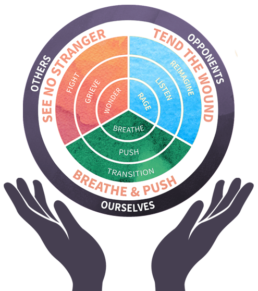8: Push

“When I was finally ready to love myself, I had to learn how to breathe and push through my grief, rage, and trauma. On the other side, I found what seemed utterly impossible before: healing, forgiveness, and even reconciliation.”
“America needs to reconcile with itself and do the work of apology: To say to indigenous, black, and brown people, we take full ownership for what we did. To say, we owe you everything. To say, we see how harm runs through generations. To say, we own this legacy and will not harm you again. To promise the non-repetition of harm would require nothing less than transitioning the nation as a whole….a nation we can only realize by doing the labor: reckoning with the past, reconciling with ourselves, restructuring our institutions, and letting those who have been most harmed be the ones to lead us through the transition.”
—Valarie Kaur, See No Stranger, Chapter 8
Understanding Push
A Practice of Love for Ourselves
To push is to choose to enter grief, rage, or trauma as part of a healing process. Pushing requires us to discern the right times to breathe and rest, and the right time to push through painful sensations, emotions, and thoughts to birth new possibilities in ourselves and others.
- Think of someone from whom you want an apology. They could be living or not. The harm they caused could have been great or small. Think of someone it is safe for you to picture. Notice what is happening in your body. If you are very activated, this is not the opponent to work with. If you can breathe through these sensations, focus on their face.
- Imagine this person apologizing to you, sincerely, deeply. They are telling you exactly what they did, with remorse in every word. They are reflecting on everything in them that led them to do it. They are fully imagining what you must have felt and the harm they caused you. They are promising you that they will not harm you again. They are taking steps in that direction. You don’t have to hear the words exactly. You’re imagining them going through these gestures. Notice what is happening in your body. If you notice some resistance or disbelief, that’s OK. This is an imaginative act. Give in to the vision.
- What does it feel like for you to receive their apology? You might notice a sense of openness, relief, and freedom. Or maybe even just a hint of this. And that’s enough. If you are ready to go deeper, continue on to the next question.
- Think of someone who you might be ready to apologize to. It could be someone specific. Or a group of people whose suffering you had not seen before. It might be the earth itself. Now imagine yourself standing before them. You are describing what you have done, the harm you have caused. You are reflecting on what led you to take those actions. You are mustering the courage to imagine how it must have made them feel. And now, you are making a promise of non-repetition of harm. You are demonstrating that you will be taking steps, so that you will not continue to harm them. As you imagine yourself giving an apology, notice what it feels like in your body. If there is tightness or constriction, feelings of guilt or even shame, breathe through it. Now imagine what impact your apology is having on the person or the group hearing your apology.
- What information have you gained about yourself? What actions are you ready to take or receive because you have imagined them first? What breathing might you need to do before you make the next push in this direction?
- What does it mean to “breathe and push” in the labor of revolutionary love?
- How can the practices of breathing and pushing lead us towards healing, accountability, forgiveness, and reconciliation?
- In what ways can breathing and pushing help us to heal and to transform, as individuals, communities, and as a nation?
- Discern when it is your time to push. Cultivate your inner wisdom to be able to answer these questions: Is now a time for me to rest and breathe? Is now a time to push, for myself and others? Who is supporting me in this labor? Who am I providing support to?
- Reflect in your wisdom journal: What is the push you are ready for? Are you to imagine receiving an apology as part of your healing process? Are you ready to give an apology? Choose one, then write out the apology letter. If you are ready to receive an apology, write the apology that you never received. If you are ready to apologize, write the apology you are ready to give. Then reflect: What sensations did you notice in your body as you engaged in this process? Were there times you wanted to stop the process? What kept you going? Remember how you pushed through the process once and know that you will be able to push through the process again.
- Learn the elements of apology. You can explore the alchemy of the apology in V (formerly Eve Ensler)’s “The Power of a Profound Apology.” You can also check out Mia Mingus’s How To Give A Good Apology and Dreaming Accountability and Brenè Brown’s discussions of accountability.
- Explore the healing practices you need to work through trauma. These may include somatic trauma therapy, meditation, yoga, stretching, dance, running, acupuncture. If you are able, work to make these healing practices available and accessible to communities who need them.
- Learn more about how to transform harm through the practices of restorative justice, community accountability, and transformative justice. Support communities of color practicing forms of transformative healing justice.

